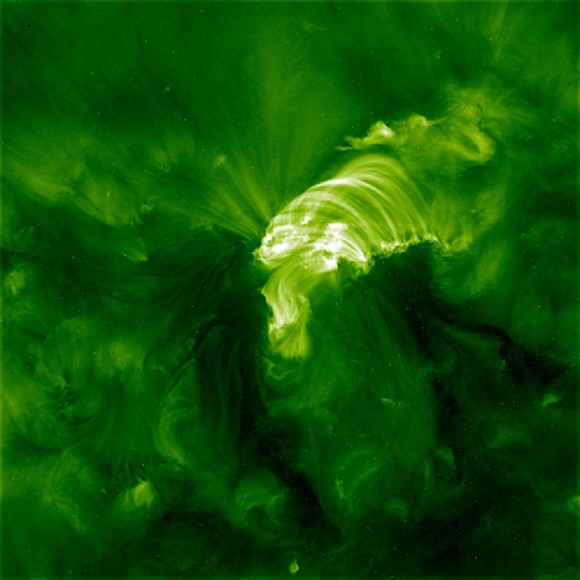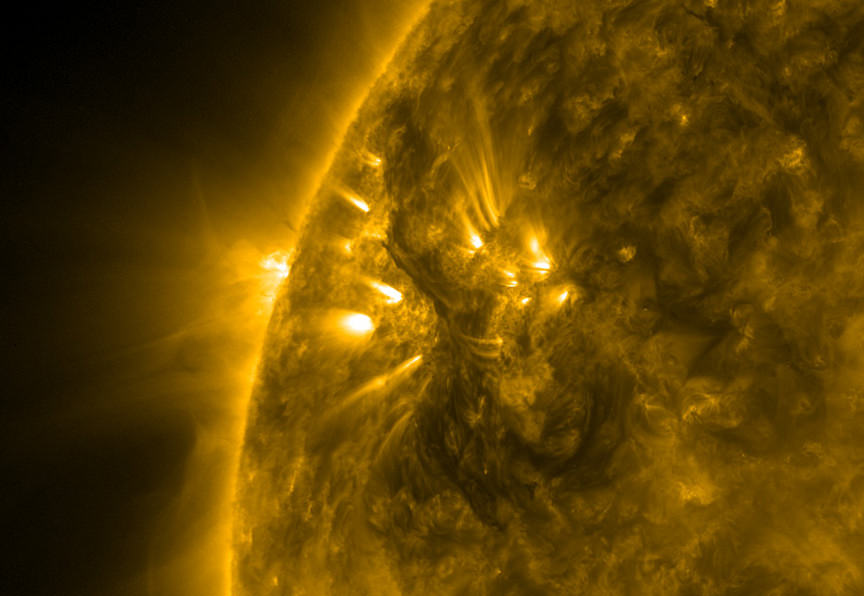[/caption]
Images and data are starting to roll in from the Solar Dynamics Observatory, and the images are nothing short of stunning. So, the SDO website has started a couple of new image gallery features, which will provide a “best of” weekly fix without overloading your Sun senses (and no sunscreen needed!) The first one is Pick of the Week. The image above is the first “pick” and what a pick it is! This SDO close-up shows a filament and active region on the Sun, taken in extreme UV light on May 18, 2010. It shows a dark and elongated filament hovering above the Sun’s surface, with bright regions beneath it. The filaments are cooler clouds of gas that are suspended by tenuous magnetic fields that are often unstable and commonly erupt. This one is estimated to be at least 60 Earth diameters long (about 805,000 km, or 500,000 miles). Wowza!
Click here to see a super-huge full disk image.
See below for another new SDO feature, Hot Shots.

Hot Shots will feature some great looking flares. This image from the Atmospheric Imaging Assembly (AIA) instrument shows a solar eruption and a flare. The dark regions show the site of evacuated material from the eruption, and the large magnetic loops were formed during the flare. AIA takes images of the solar atmosphere in multiple wavelengths to study link changes in the surface and how they related to interior changes in the Sun. AIA takes images of the Sun in 10 wavelengths every 10 seconds.
For more see the SDO website.


Thanks Nancy! SDO is a fantastic mission and will no doubt revolutionize solar physics – if it hasn’t already!
Every moment now I expect some post with some tons of copy and paste spamming quotes to p****a science, and a link to a E*/P*.
But the images are fantastic.
I took an astrophysics course many moons ago which modelled a star according to a gravitational hydrostantic model. This is of course a grad school theory, so I don’t know that much about stellar or solar physics. There is a vast amount of complexity here, which does involve plasma physics and MHD. So I suppose we have to throw a bone or two at these guys.
LC
@ Lawrence B. Crowell,
Well, nobody here is disputing the fact that the Sun and other stars are, indeed, balls of hot plasma; however, it’s when “the usual suspects” start with their BS about the “Electric Sun” is when I start having a problem with “Be nice” to those guys!
If the sun’s diameter is about 800,00 miles, how is it possible that the filament shown in the photo is 500,000 miles long? Must be some mistake.
@dshander Those filament are going into space and come back. It is a big loop. And the sun diameter is about 865000 miles. I think you forgot a 0 😉
It is sad that we cannot discuss the plasma physics in a scientific way without waking up some fundy starting to spam this site with pointless quotes and links just to increase google search to his site. I find the plasma physics very interesting but once the fundy spam starts it becomes BS fast.